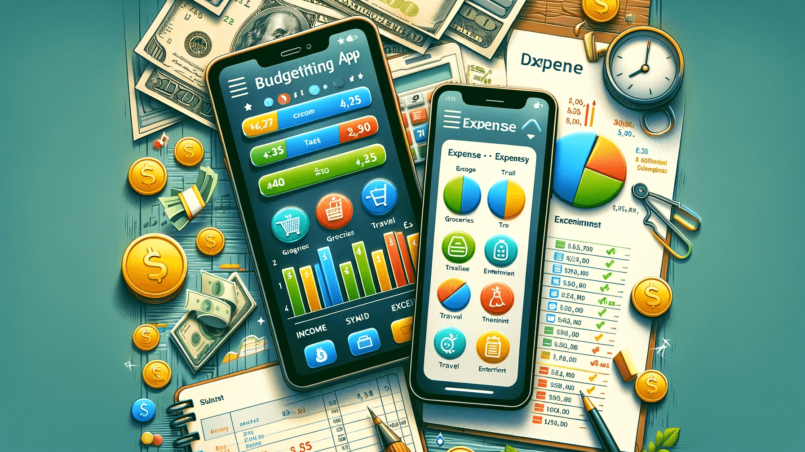Share this
In today’s digital era, managing personal finances effectively is crucial for financial well-being. Personal finance and budgeting software offers a streamlined and efficient way to track expenses, create budgets, and plan for the future. This article explores the importance of these tools, highlights top software options, and provides guidance on selecting and using them to achieve financial goals.
The Importance of Personal Finance and Budgeting Software
Personal finance and budgeting software simplifies the complex task of managing money by providing a centralized platform to monitor income, expenses, investments, and debts. These tools offer several key benefits:
1. Comprehensive Financial Overview
Personal finance software provides a complete view of your financial health by consolidating all your accounts, transactions, and investments in one place. This holistic approach helps in making informed financial decisions.
2. Expense Tracking
By categorizing and tracking expenses, budgeting software helps identify spending patterns and areas where you can cut back. This insight is essential for creating realistic budgets and saving money.
3. Budget Creation and Management
Budgeting tools allow you to set spending limits for different categories, such as groceries, entertainment, and transportation. They provide alerts and insights to help you stay on track with your financial goals.
4. Goal Setting
Many personal finance tools offer features to set and track financial goals, such as saving for a vacation, buying a car, or paying off debt. They provide progress updates and motivate you to stay focused on achieving your objectives.
5. Bill Reminders and Alerts
Automated reminders for upcoming bills and payments help avoid late fees and penalties, ensuring that you stay current with your financial obligations.
6. Investment Tracking
Some software includes tools for tracking investments and analyzing portfolio performance. This helps in making informed decisions about buying, selling, or holding assets.
7. Security and Privacy
Reputable personal finance and budgeting software prioritizes security by using encryption and other measures to protect your financial data from unauthorized access.
Top Personal Finance and Budgeting Software
1. Mint
Mint is one of the most popular personal finance tools, known for its user-friendly interface and comprehensive features.
- Key Features: Expense tracking, budget creation, bill reminders, investment tracking, and goal setting.
- Pros: Free to use, easy to set up, and provides a complete financial overview.
- Cons: Ad-supported, and some users may find the categorization of transactions to be inaccurate at times.
2. YNAB (You Need A Budget)
YNAB focuses on proactive budgeting and financial management, encouraging users to allocate every dollar to a specific purpose.
- Key Features: Budgeting, goal setting, debt tracking, and detailed financial reports.
- Pros: Effective for users who want to get out of debt and save money. Offers educational resources and community support.
- Cons: Subscription-based with a learning curve for new users.
3. Quicken
Quicken is a robust personal finance software that offers a wide range of features for managing finances and investments.
- Key Features: Budgeting, bill management, investment tracking, and financial planning.
- Pros: Comprehensive tool with advanced features for serious financial management.
- Cons: Higher cost compared to other software and can be complex for casual users.
4. Personal Capital
Personal Capital is ideal for those who want to manage both their day-to-day finances and investments.
- Key Features: Expense tracking, budgeting, retirement planning, and investment analysis.
- Pros: Offers a blend of personal finance and investment tools, with a free financial dashboard.
- Cons: Focuses more on investment tracking, with fewer budgeting features compared to other tools.
5. PocketGuard
PocketGuard simplifies budgeting by showing how much disposable income you have after accounting for bills and savings goals.
- Key Features: Budgeting, expense tracking, and bill management.
- Pros: User-friendly and provides a clear picture of available funds.
- Cons: Limited investment tracking and advanced features.
6. Goodbudget
Goodbudget uses the envelope budgeting system to help users allocate funds for different spending categories.
- Key Features: Budgeting, expense tracking, and goal setting.
- Pros: Easy to use and effective for envelope budgeting. Available on mobile and web.
- Cons: Lacks investment tracking and other advanced features.
7. Simplifi by Quicken
Simplifi offers a modern approach to personal finance, focusing on simplicity and ease of use.
- Key Features: Budgeting, expense tracking, goal setting, and bill management.
- Pros: Intuitive interface and streamlined features for quick financial management.
- Cons: Subscription-based with fewer advanced features compared to Quicken.
How to Choose the Right Personal Finance and Budgeting Software
1. Assess Your Needs
Determine what features are most important to you, such as budgeting, investment tracking, or bill management. Choose software that aligns with your financial goals and management style.
2. Consider Cost
Evaluate the cost of the software, including subscription fees or one-time purchases. Some tools offer free versions with basic features, while others may require payment for advanced capabilities.
3. Check Compatibility
Ensure that the software is compatible with your devices and financial institutions. Look for tools that offer mobile apps for on-the-go management and support for your bank accounts.
4. Read Reviews
Read user reviews and expert opinions to gauge the software’s performance, reliability, and customer support. Reviews can provide insights into potential issues and the overall user experience.
5. Test the Software
Many personal finance tools offer free trials or demo versions. Take advantage of these to test the software and see if it meets your needs before committing to a purchase.
6. Evaluate Security Features
Check the security measures in place to protect your financial data. Look for software that uses encryption, two-factor authentication, and other security protocols.
7. Consider Support Options
Choose software that offers reliable customer support through multiple channels, such as phone, chat, or email. Good support is essential if you encounter issues or need assistance.
Best Practices for Using Personal Finance and Budgeting Software
1. Regularly Update Your Accounts
Keep your financial accounts updated in the software to ensure accurate tracking of income, expenses, and investments. Regular updates provide a real-time view of your financial health.
2. Categorize Transactions
Consistently categorize your transactions to track spending accurately. Most software allows you to create custom categories to match your spending habits.
3. Set Realistic Budgets
Create realistic budgets based on your income and spending patterns. Use historical data from the software to set achievable limits for each spending category.
4. Monitor Progress
Regularly review your financial progress against your budgets and goals. Use the software’s reports and insights to identify areas where you can improve or adjust your spending.
5. Automate Bill Payments
Set up automatic bill payments through the software to avoid late fees and penalties. Automation ensures that your bills are paid on time and helps maintain a good credit score.
6. Plan for Savings
Allocate funds for savings goals, such as an emergency fund, vacation, or retirement. Use the software to track your progress and adjust your contributions as needed.
7. Review Investment Performance
If the software includes investment tracking, regularly review your portfolio’s performance. Use the insights to make informed decisions about buying, selling, or rebalancing assets.
8. Protect Your Data
Use strong passwords and enable security features like two-factor authentication to protect your financial data. Be cautious when accessing the software on public Wi-Fi networks.
9. Stay Informed
Keep informed about personal finance best practices and updates to the software. Regularly read articles, attend webinars, and engage with the software’s community for tips and advice.
10. Seek Professional Advice
Consider consulting a financial advisor if you need help with complex financial planning or investment strategies. Professional advice can complement the insights provided by personal finance software.
Future Trends in Personal Finance and Budgeting Software
1. Artificial Intelligence and Machine Learning
AI and machine learning are enhancing personal finance software by providing more accurate spending predictions, personalized insights, and automated financial planning.
2. Integration with Financial Services
Future software is likely to offer deeper integration with financial institutions, providing seamless account management and real-time updates. This will improve the accuracy and timeliness of financial data.
3. Voice Assistants
Voice-activated personal finance management through smart assistants like Alexa and Google Assistant will become more common, offering hands-free access to financial information and transactions.
4. Enhanced Mobile Features
Mobile apps will continue to evolve with more advanced features, such as augmented reality for budgeting and spending analysis, and improved user interfaces for on-the-go financial management.
5. Focus on Privacy
As data privacy concerns grow, personal finance software will prioritize enhanced privacy features, such as anonymized data, end-to-end encryption, and transparent data policies.
6. Sustainability Tracking
Future tools may include features to track the sustainability and ethical impact of spending, helping users make more environmentally and socially responsible financial choices.
7. Blockchain Integration
Blockchain technology may be used to enhance security, transparency, and trust in financial transactions, particularly for investment and cryptocurrency management
Conclusion
Personal finance and budgeting software offers invaluable assistance in managing money, setting financial goals, and planning for the future. Whether you’re a novice looking for basic budgeting tools or a seasoned investor needing comprehensive financial oversight, there is software available to meet your needs.
By consolidating all financial activities into a single platform, these tools provide a complete financial overview, simplify expense tracking, and facilitate effective budget management. They help in identifying spending patterns, avoiding debt, and planning for significant financial goals such as buying a home or saving for retirement.
When choosing personal finance software, it’s important to consider your specific requirements, such as the need for advanced investment tracking or simple budgeting capabilities. Assess factors like cost, user experience, compatibility, and security features to ensure that the software aligns with your financial management style.
Following best practices like regularly updating your accounts, categorizing transactions accurately, setting realistic budgets, and protecting your financial data can maximize the benefits of personal finance software. Staying informed about new features and updates will further enhance your financial management capabilities.
As technology evolves, personal finance tools will continue to integrate advanced features like artificial intelligence, voice assistance, and enhanced privacy measures, making them even more effective and user-friendly. Embracing these tools now can set you on a path to better financial health and greater peace of mind.
Ultimately, personal finance and budgeting software can transform the way you manage your money, providing clarity, control, and confidence in your financial journey.


